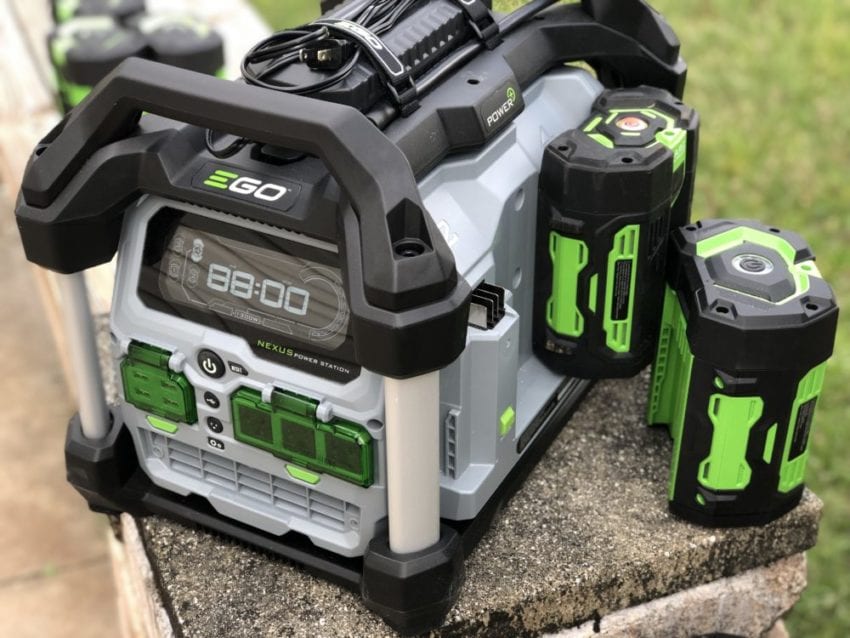The EGO Nexus Power Station Offers Balances Customizable Capacity, Power, and Price
The EGO Nexus Power Station is giving lithium-ion power supplies a kick in the pants with its unorthodox modular design. I say unorthodox because until power tool companies started getting in the game, most battery inverters had large internal batteries.
Pros
- Capable of powering many 15A tools
- Flexible lithium-ion power source options – use one to four EGO 56V batteries in any capacity combination
- Nearly silent, emission-free power
- 2000-watt continuous power handles up to 3000 surge watts
- Easily replaceable/upgradable batteries
- Large, bright LCD screen
- Simple yet useful app offers controls and more detailed info
- Firmware updates offer easy and free upgrades down the road
- Roll cage offers extra protection
- Solar adapter now available
Cons
- Onboard capacity is well under some brands’ max
- Won’t make it past the startup surge of all 15-amp motors
EGO Nexus Power Station Output
This system is a far cry from the EGO Nexus Escape which outputs 150 watts. The EGO Nexus Power Station can output up to 2000 continuous watts with 3000 peak watts out. Those are pure sine surge watts and at 50% over its continuous output rating, it exceeds what a 2000-watt gas generator/inverter can do by a long shot.
The Power Station runs on any combination of EGO 56V batteries. The EGO battery inverter possesses 4 ports, but you don’t have to use all of them. You can use just one if you want. The type of battery (or batteries) determines your maximum output watts. With a 1P pack (2.0 or 2.5 Ah), it runs at 600 watts. It bumps up to 1200 watts of output with a 2P (5 Ah) battery. To get the 2000-watt maximum, you need to run at least one 3P (7.5 Ah) battery or equivalent in smaller packs.
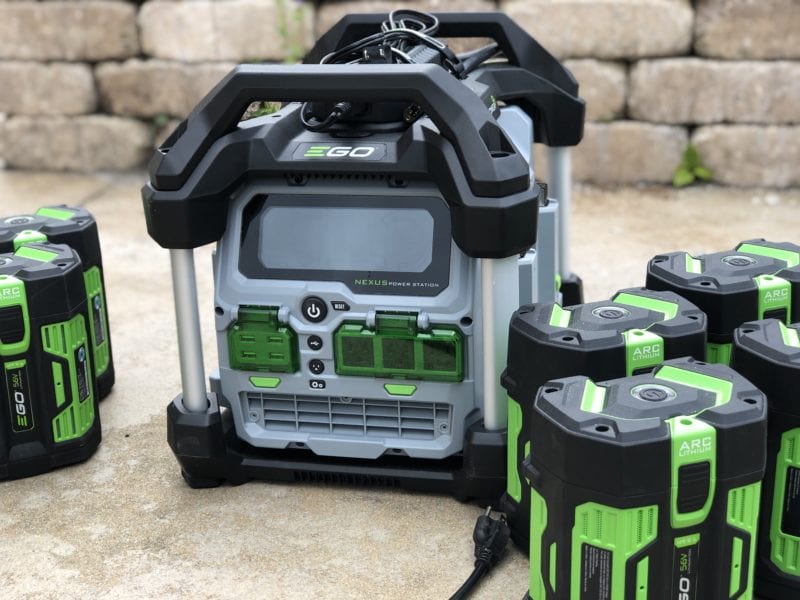
It’s really about the number of cells. EGO’s 56V battery runs on 14-cell groups. 14 cells on the Power Station gives you 600 watts and 28 cells bump it to 1200 watts. With 42 cells or more, you get the maximum 2000 watts output. It doesn’t matter what combination of batteries you use.
You can also mix batteries without issue. When you use batteries with different capacities or charge states, the EGO Nexus Power Station will draw down the highest one(s) first until they’re all at the same level. Then it pulls equally from all battery packs together.
Real World Testing
So what can you do with 2000 continuous watts and 3000 surge watts? A lot, apparently.
Goal Zero’s Yeti 3000 moved us into the 13-amp range for corded tools. The EGO Nexus Power Station will run 15-amp tools. I started with a standard 15-amp sidewinder circular saw cutting 3/4″ OSB subfloor and then stacked it to make 1.5″ cuts with a 15-amp Skilsaw worm drive saw. Even pushing the worm drive, I didn’t trip the Power Station.

Out of curiosity (and because it was 85º in mid-February), I plugged in our 17,500 CFM drum fan and ran it on high to see if I could still cut with that sidewinder at the same time. It turned out that I could. Of course, you can trip the unit if you push too hard. The fan puts out an additional 900 watts, or 7.3 amps. Running that and pushing the saw harder brings the total draw higher than 2000 continuous watts.
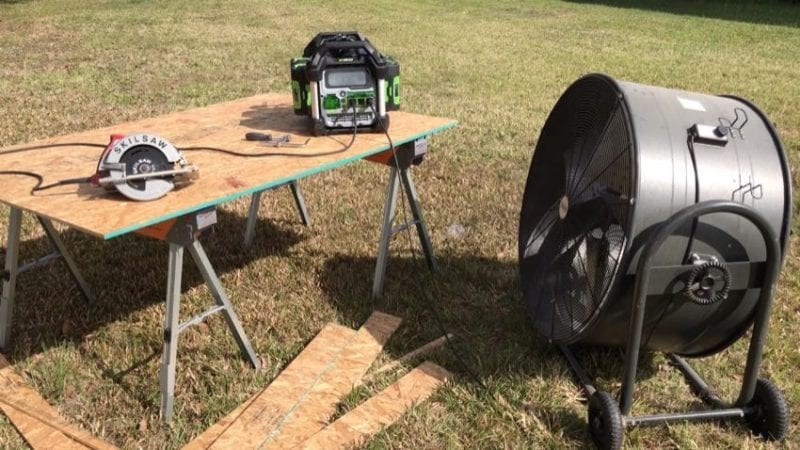
We also tested Skilsaw’s larger worm drive table saw and that seems to be where the limit is. This battery-powered inverter can’t currently handle the startup surge on that tool.
I say “currently” intentionally. One of the beautiful things about this kind of inverter is that the electronics and Bluetooth/WiFi connections permit firmware updates. If EGO finds they can better optimize the output, an update can be made available to download.
So far, the only battery inverters that have been able to make cuts on that saw is DeWalt’s Portable Power Station and Milwaukee’s MX Fuel Carry-On. The trade-off is that both are more limited in onboard battery capacity.
Resetting
This seems like a good time to talk about resetting the Power Station when you exceed its limits. The electronics make this very easy. Just turn the main power switch off and back on, turn your outlets on, and power is restored. Alternatively, hold down the blinking reset button for 3 to 4 seconds, then turn your outlets back on. Either method works fine.
EGO Nexus Power Station Capacity
The total capacity of the EGO Power Station is the sum of the batteries you put on it. Stick four 2.5 Ah packs on it and you get 560 watt-hours to work with (140 watt-hours x four batteries). Here’s what some other options look like:
- 4 x 5.0 Ah batteries: 1120 watt-hours
- 4 x 7.5 Ah batteries: 1680 watt-hours
- 4 x 10.0Ah batteries: 2240 watt-hours
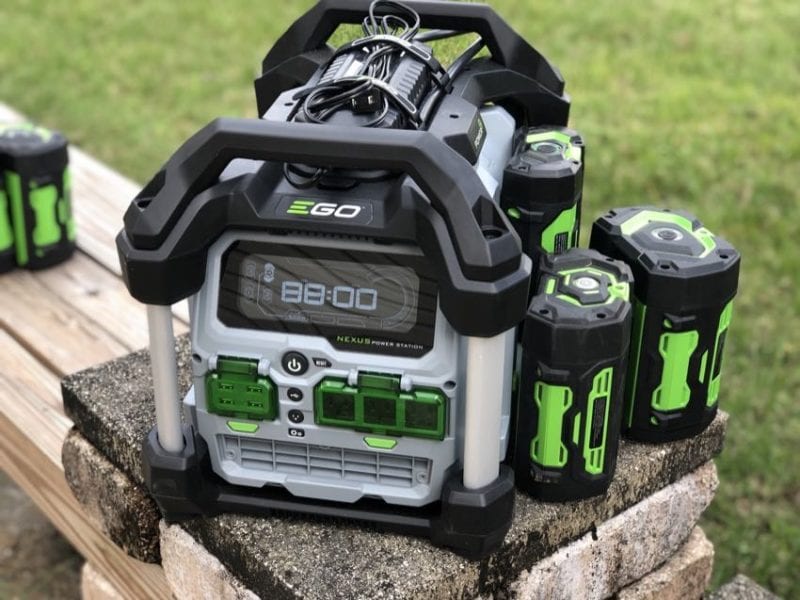
While some fully enclosed units can push 3000 watt-hours or more, modular systems such as EGO stop well short of. However, it’s easier to get your hands on spare batteries if you need more capacity. And remember that the Power Station can run on just one battery.
EGO Nexus Power Station Charging
It seems curious that the charging unit is external, but that’s intentional. It gives EGO the option of offering an upgraded rapid charger down the road without needing any modifications.
When our 7.5 Ah batteries arrived, they were nearly dead (1 bar each). It took just under 13 hours to complete the charge cycle. Your charge times will vary based on the batteries you use. The onboard charging port pulls 170 watts (EGO’s standard charger is 210 watts and their quick charger is 550 watts). Here are some estimated optimal charging times:
- 4 x 2.5Ah: 4 hours, 3 minutes
- 4 x 5.0Ah: 8 hours, 7 minutes
- 4 x 7.5Ah: 12 hours, 10 minutes
- 4 x 10Ah: 16 hours, 14 minutes
When you plug the charger in, the LED screen will tell you the estimated charge time once it stabilizes.
If you have more than one battery on board, the charger automatically switches from one battery to the next. Instead of fully charging before moving on, it switches at a consistent interval. This keeps the group’s charge state close in case you need it before all batteries fully charge.
One important note: You can’t charge and discharge at the same time. If you power anything and plug in the charger, it cuts the power and prioritizes the charge cycle.
Update: Solar is Now an Option!
There’s now a solar adapter you can use with standard solar panels. EGO doesn’t sell any panels at this stage, but we were able to use a commercially available set we got our hands on without a problem. Note that you can connect a maximum of 180 watts of solar to the unit.
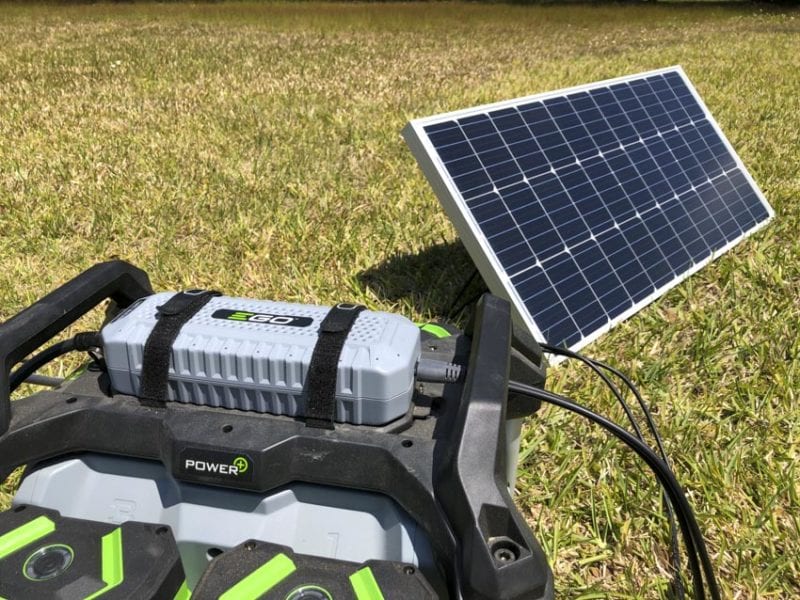
EGO Nexus Power Station Additional Details
Firmware
Check and see if there’s a firmware update straight away. Some of the earlier units may need it. They’ll still run, but they’ll run better and have the latest firmware after the update.
New vs Old Batteries
Any EGO 56V batteries work in the Power Station, but they may perform differently. The original EGO batteries have a red/yellow/green level indicator that blinks like a Christmas tree when inserted into the Nexus.
The newer batteries have a 5-LED ring to give you a better idea of how much charge you have and aren’t as “festive”.
One other thing—the original batteries can put out up to 90 amps (5,040 watts) of power. The newer packs produce up to 130 (7,280 watts)! There’s an 80-amp fuse on the Power Station, so you won’t access all of that potential.
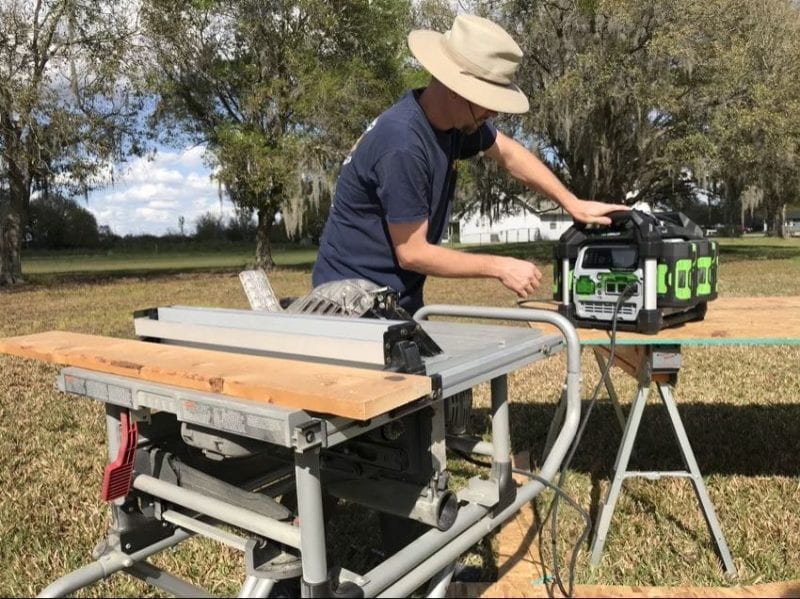
Add a Battery in Use
Did one of your batteries go dead? You can pop a charged one in while the Power Station is running without interrupting your power. It’s kind of like adding gas to a running generator—except this battery-powered generator runs on lithium-ion cells.
Roll Cage Design
Dropping a battery inverter off your tailgate probably means the end of it unless you’re using the EGO Nexus power inverter. Its roll cage gives it a fighting chance to survive. EGO intentionally designed it to let the batteries pop off to avoid worse damage.
Environmental Conditions
The EGO Nexus Power Station has an IPX4 rating. It can handle splashing water for 10 minutes, but it’s not designed to leave out in a storm. Since it produces no emissions, there’s no problem bringing it inside the tent or cabin with you. Besides, do you really want a family of bears plugging in and watching TV while they eat all the food from your cooler?
High-Vis LCD Screen
The LCD screen has a black background with easy-to-read white and red graphics—even in bright sunlight. The display is also larger than Kohler and Goal Zero, making it easier for those of us who can’t see like we used to.
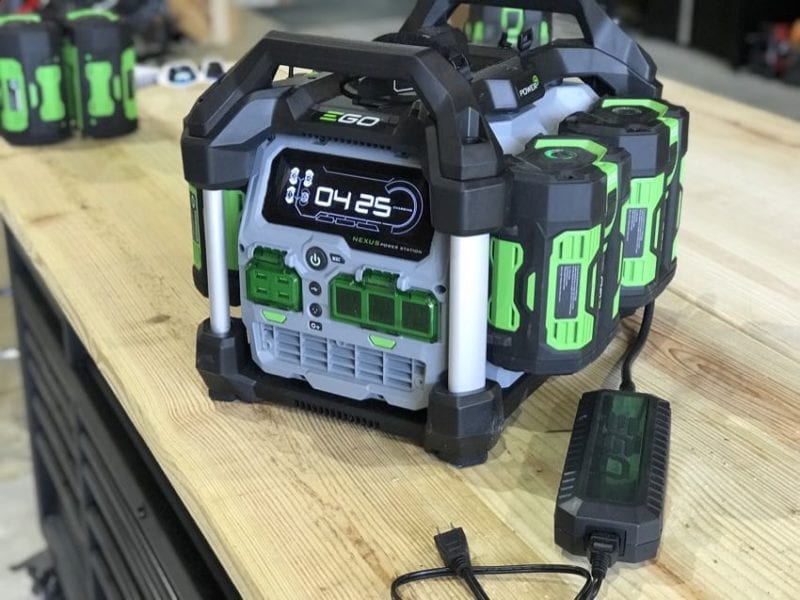
Not Crazy Heavy
Even with the batteries onboard, I can carry the Nexus pretty well thanks to the handle design. I don’t really want to lug it a long distance, though. It weighs a little over 29 pounds bare and 54 pounds with four 7.5 Ah batteries. The charger and cords add another 2 pounds.
EGO Nexus Power Station App
The LCD screen gives you valuable feedback, but you can see more details in the app. Here’s what you can do/view:
- Toggle between Bluetooth and WiFi connection
- View current watts out per outlet
- Turn outlets on/off (full bank of USB and individual outlets)
- View battery charge status on each port as a percentage
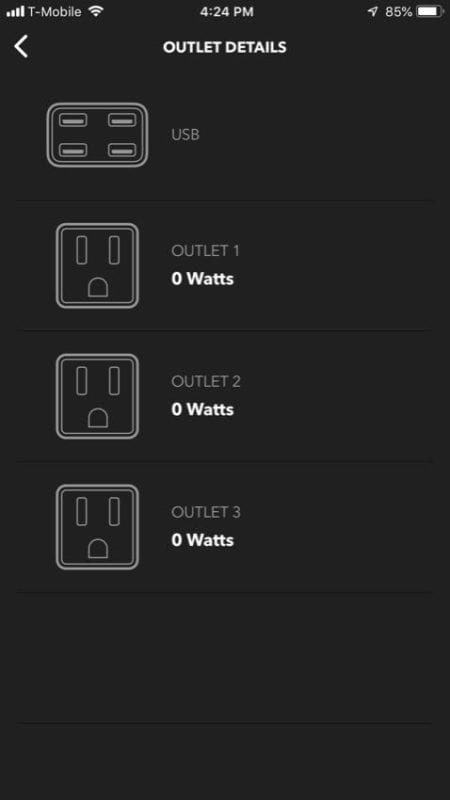
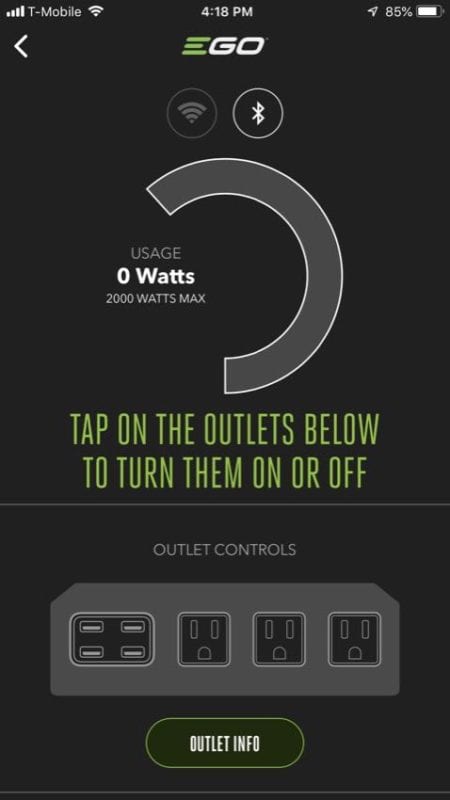
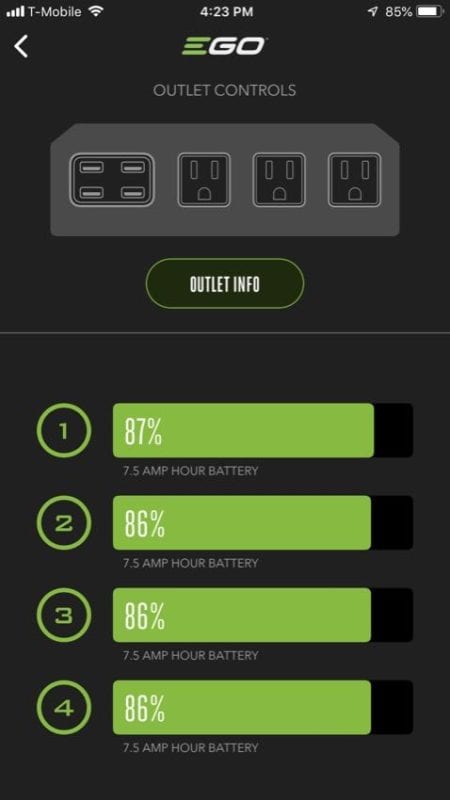
Who is the EGO Nexus Power Station For?
The EGO Nexus Power Station works well as a quiet, emission-free power supply for jobsites, camping/hunting, emergency power, tailgating, and more. The potential use for providing emergency power really sheds some light on the benefits of a device like this. If you’re a homeowner, you can stick your gas generator outside and enjoy most of your comforts after a storm.
But what if you’re in a 5th-story apartment?
You can run the Power Station inside without any fear of building carbon monoxide. It’s a great solution for folks that live in the city, especially considering the average power outage is just 3 hours.
That isn’t quite as reassuring in hurricane and earthquake-prone areas where outages often last for days. However, EGO does have solar panel compatibility. That’s something that makes it a better option for multi-day outages or off-the-grid days. I’d max out the 180 watts of panels to get a reasonable charge during the day.
EGO Nexus Power Station Price
There’s a pretty wide spread of prices depending on what kind of capacity you need. EGO is kitting the Power Sation four 5.0 Ah batteries for $1299 or two 7.5Ah batteries for $999. If you already have EGO batteries you want to use, the bare unit is $499. Here’s how Milwaukee and DeWalt compare:
- Milwaukee MX Fuel Power Supply: $2299 with 2 extended capacity batteries
- DeWalt Portable Power Station: $529 with no batteries
The Bottom Line
The EGO Nexus Power Station is the most capable, best battery-powered inverter we’ve tested so far. It lets you run tools like 15-amp handheld worm drive saws. That may get even better with firmware updates. While short of matching the total capacity of the Goal Zero Yeti 3000 on its own, the flexible design makes it easy to carry extra batteries in reserve if needed. Whether you’re looking for no emissions, low noise, or just need to run your power source inside, the EGO Nexus Power Station is pushing your access to reliable power further.

